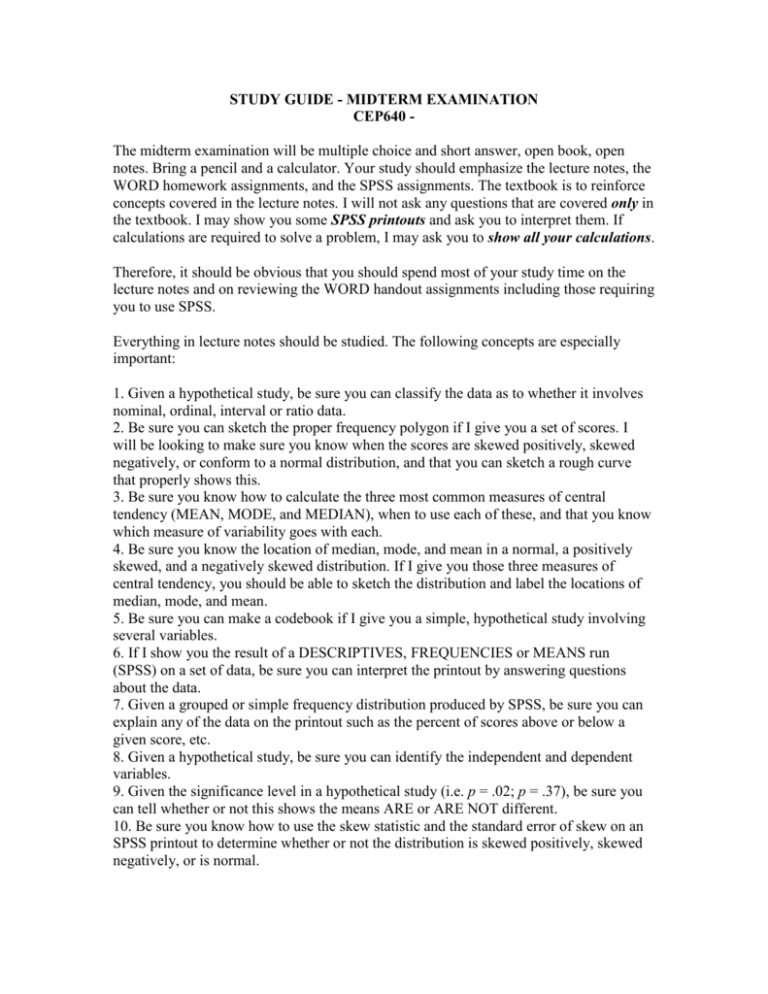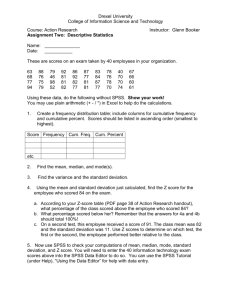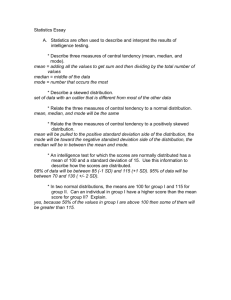studyguidetest1
advertisement

STUDY GUIDE - MIDTERM EXAMINATION CEP640 The midterm examination will be multiple choice and short answer, open book, open notes. Bring a pencil and a calculator. Your study should emphasize the lecture notes, the WORD homework assignments, and the SPSS assignments. The textbook is to reinforce concepts covered in the lecture notes. I will not ask any questions that are covered only in the textbook. I may show you some SPSS printouts and ask you to interpret them. If calculations are required to solve a problem, I may ask you to show all your calculations. Therefore, it should be obvious that you should spend most of your study time on the lecture notes and on reviewing the WORD handout assignments including those requiring you to use SPSS. Everything in lecture notes should be studied. The following concepts are especially important: 1. Given a hypothetical study, be sure you can classify the data as to whether it involves nominal, ordinal, interval or ratio data. 2. Be sure you can sketch the proper frequency polygon if I give you a set of scores. I will be looking to make sure you know when the scores are skewed positively, skewed negatively, or conform to a normal distribution, and that you can sketch a rough curve that properly shows this. 3. Be sure you know how to calculate the three most common measures of central tendency (MEAN, MODE, and MEDIAN), when to use each of these, and that you know which measure of variability goes with each. 4. Be sure you know the location of median, mode, and mean in a normal, a positively skewed, and a negatively skewed distribution. If I give you those three measures of central tendency, you should be able to sketch the distribution and label the locations of median, mode, and mean. 5. Be sure you can make a codebook if I give you a simple, hypothetical study involving several variables. 6. If I show you the result of a DESCRIPTIVES, FREQUENCIES or MEANS run (SPSS) on a set of data, be sure you can interpret the printout by answering questions about the data. 7. Given a grouped or simple frequency distribution produced by SPSS, be sure you can explain any of the data on the printout such as the percent of scores above or below a given score, etc. 8. Given a hypothetical study, be sure you can identify the independent and dependent variables. 9. Given the significance level in a hypothetical study (i.e. p = .02; p = .37), be sure you can tell whether or not this shows the means ARE or ARE NOT different. 10. Be sure you know how to use the skew statistic and the standard error of skew on an SPSS printout to determine whether or not the distribution is skewed positively, skewed negatively, or is normal. 11. Be sure you know how to use the kurtosis statistic and the standard error of kurtosis on an SPSS printout to determine whether or not the distribution is leptokurtic, platykurtic, or mesokurtic (normal). 12. Given the median and the IQR of a distribution, be sure you can figure out Q1, Q2, or Q3. 13. Be sure you know how the interquartile range relates to the semi-interquartile range, and you are able to convert one to the other. 14. Be sure you can calculate the biased and unbiased standard deviation of a set of scores using either the conceptual (definitional) or the calculation formula for each. 15. Be sure that if I give you the significance level (sig. or p value) of a statistical test, you can tell me whether the test was significant or not. (Always consider a p value (sig.) of.05 or less to be significant unless I tell you to use another level such as .01.) 16. Be sure that if I give you an equation to solve, you know the proper order of operations (what arithmetic processes to do first, second, etc.) so that you can solve the equation. 17. Be sure you know how to look at descriptive statistics from two distributions and tell which of the two is most variable. 18. Be sure you can calculate a z score if I give you a raw score and the mean and SD of the distribution from which it came. 19. If I give the mean and SD of a distribution, then ask you to tell me the percent of cases scoring above or below a given raw score, be sure you can do that. The steps would be: a. convert the given score to a z-score b. draw a picture of a normal curve and locate the z score by placing a dot at the proper spot. c. look up the % of cases between the mean and that z-score in a z-score table d. add or subtract that percentage from 50%, depending on the problem 20. If I give you two scores on a test with known mean and standard deviation, be sure you can tell me the percent of cases between these two scores. The steps would be: a. convert both scores to z scores b. draw the distribution putting a dot on the curve to represent each z score. c. Look up both z scores in a normal curve table d. calculate the percent of cases between the two z scores. 21. If I give you a set of scores, be sure you could use the rules I gave you in lecture notes to pick the proper interval size (i.e. 20-24 is an interval size of 5) for constructing a grouped frequency distribution for that data. 22. Be sure you can do a hypothesis test in a study in which there is one case in the sample and you know the mean and standard deviation of the comparison distribution. You should be able to write null and alternate hypotheses and tell me whether or not the test was significant and in which direction. 23. Be sure you can do simple problems using your textbook's notion of ADD-OR and MULT-AND (p. 133 in text).







